Implementing and maintaining the appropriate Link Building Strategy is essential to improve your websites’ SEO performance, and rank higher than your competitors. Link Building Velocity – how fast a website should aim to generate backlinks to increase SERP rank, has become a point of controversy inside of the SEO community. Essentially, a site should aim to build links at a similar or slightly higher rate than that of its competitors, if these are built too fast, it may trigger a red flag within Googles’ internal processes. This article will explain Link Building Velocity in-depth, as well as how to leverage this factor to your sites’ best interest.
What Is Link Building Velocity?
Link building is the strategy taken upon by SEO experts to create hyperlinks from other websites to their own. This is the foundation of most effective SEO strategies, its’ role is critical to seizing organic traffic from search engines; particularly in the most competitive industries like the online casino industry. Essentially, the more high-quality links a site has pointing towards it, the more exposure it will get.
Link building velocity can be defined as the yardstick for the timetable of your link building activities. This is the speed at which links are being built over a specific period of time. The period specified is usually the number of monthly links being added to your sites’ backlink profile. The SEO community created this idea of link building velocity. Its’ validity as a ranking factor has been discussed ever since. This all started from the discovery of a patent named Information Retrieval Based on Historical Data from 2003. This patent covers many areas but has a short paragraph that infers the idea of Link Building Velocity. This, coupled with a wealth of anecdotal evidence from the experience of SEO’s, birthed the concept of link building velocity.
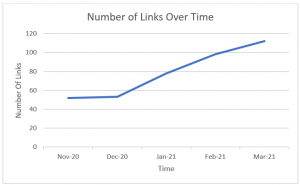
The above graph is an example of an appropriate increase of link building velocity. In November 2020, the velocity was 52, by March 2021, it reached 112 through a steady increase. The example is based on a typical online casino platform. This means that it is in one of the most competitive markets in the world. Of course, we must also take into consideration, that those links also include natural links, and are subject to seasonality. If we were to take a macro-approach view, the graph would have highs and lows, and not a straight line.
Recently, John Mueller, the Senior Webmaster Trends Analyst at Google, had this to say about the idea that Link Building Velocity as a factor in site ranking. “From my point of view[…]200 backlinks in two days[…] then that sounds a lot like you’re not getting natural backlinks. That sounds a lot like you’re going off and just buying them or having someone buy them for you. And that itself would be kind of the thing that we would not be happy with.”
Source – Search Engine Journal
This infers that Mueller denies that the link building velocity itself increases ranking. However, we need to make backlinks look natural to avoid a manual review from Google. This would result in a penalty that may decimate the ranking that you would have worked so hard to achieve. That being said, it is important to take Mueller’s words with a pinch of salt. Meaning that although it is important to maintain a ‘natural looking’ link building velocity, if an article on your site goes viral and your backlink profile is increased dramatically, your search rankings will enjoy a very positive outcome.
Calculating Link Building Velocity
The first step to deciding the appropriate link building velocity would be to understand your current velocity. We need to take into consideration your already existing referring domains, as well as your existing backlinks. Referring domains are the external websites that contain backlinks to your page. Existing backlinks refers to the raw number of links pointing to your page. You can do this with many SEO tools, however, in this instance, we are going to recommend using ahrefs.com.
How to Calculate Current Link Building Velocity
Step 1 – Log in to ahrefs.com and open up the dashboard.

Step 2 – Search the website that you want to examine. In this case, we are going to use https://www.investopedia.com a trusted and reputable source for financial information in a variety of industries.
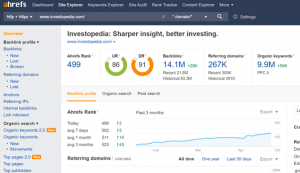
As we can see, this is an extremely high-quality site with a 91 Domain Ranking. The domain also boasts an enormous number of backlinks and referring domains. This is a great example of a site with a strong SEO strategy.
Step 3 – On the left pane, under Backlinks, select New. The tool provides us with a calendar of new backlinks each day for the past months. Make sure to also select the ‘One link per domain’ option, as well as ‘Dofollow’ under ‘Link Type’. This view clearly displays the links generated, as well as the links lost across each month. It is also worth noting that this shows links built organically as well as through link building activities.
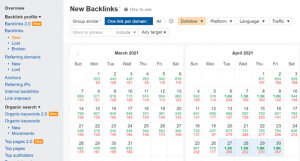
From here, we can simply add up the number of backlinks created each month, as well as those deleted. In this case, the new Backlinks report for months February, March, and April 2021 is as follows :

As we can see the number of backlinks towards Investopedia.com, is increasing over time.
Step 4 – We can also do this same process for referring domains. This lists both the new referring domains, as well as those lost.
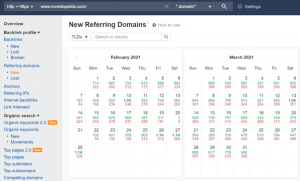
From here, we can simply add up the number of referring domains that were created each month, minus those lost. For Investopedia, the Referring Domains for months January to April 2021 are as follows:
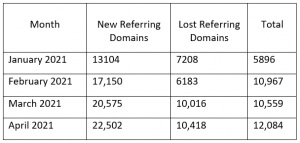
Alternatively, if you are MS Excel savvy, we can do this faster by exporting the data into an Excel CSVs. From the above table, we can see the velocity of referring domains for investopedia.com, is increasing.
Does this mean that Investopedia is paying for 12,000+ backlinks per month? No, howver, with such a high-quality site, links are built organically to it. We can expect it to stay ahead of its competition in this regard for some time to come.
Critical Factors To Consider
If you came to this article to find that special magic number for the best link building velocity for your site, unfortunately, the best answer anyone can provide you with is ‘it depends on your context’. This answer is incredibly frustrating, however, it is the truth. The link building velocity that you start with and work up to is entirely dependent on the context of your industry and is subject to a lot of nuance.
There are many factors to consider within your link building velocity strategy. Primarily, one should not sacrifice the quality of backlinks, for the sake of higher link building velocity. There are many factors to consider when deciding whether a site is of quality, and can be used for a backlink. Some of these factors are:
- Spam Score
- PBN Sites
- Site Performance, Design, and Content
- Topicality
- Anchor Text Distribution
- Budget
Spam Score
You can find out the spam score of a site by using the moz.com tool, a Google Chrome extension. This metric created by Moz is the industry standard to check whether a site has the potential to be a spam website. The tool analyses the site for a percentage of features or content that has been penalized or banned by Google. It is critical to stay away from sites with higher spam scores.
PBNs
PBNs or private blog networks are sites that contain very large quantities of links to other websites. These are low quality and are designed specifically to manipulate search engine rankings. These are tempting to use as they often have good authority and can get good traffic from them. However, they are simply a Google penalty waiting to happen. These violate Google’s Webmaster Quality Guidelines, it is simply recommended to steer clear from them unless there are specific circumstances.
Site Performance, Design, and Content
When deciding whether or not to use a specific site for link building purposes, it is also a good idea to read through the site and ensure that they are a good organization to do business with. It would not be ideal to work with a site that has a shoddy design, is very slow to load pages, and is generally unimpressive to look at. Sites with these aspects are very often of lower quality, and so have little value to offer in terms of link building. Moreover, it is paramount to ensure that any prospective site does not have controversial, or politically controversial content. It is bad practice to link your site, and therefore brand image, to such agendas.
Topicality
This factor is very straightforward. If for example, you wish to build traffic for your site which is about gym equipment, then the sites you should be using for link building purposes should relate to the health and fitness space. Building links in completely different areas, such as websites about the latest console games, will not be ideal for two reasons.
Firstly, it is telling Google that this link is there specifically for link building purposes, which may trigger a penalty if found. Secondly, the percentage of readers on a website about the latest console games, that are interested in gym equipment, will be lower than that of a website about health and fitness itself. Conversely, it is a still good idea to branch out into other areas as long as you can relate to your site. Proceeding with the same example, an article about home gyms and their benefits would fit perfectly on a home improvement and DIY website and can link back to your page about gym equipment very naturally.
Anchor Text Distribution
Anchor text distribution is fairly simple to understand. This is the visible text that contains the hyperlink. These are the characters that we click on that will take us to a site. It is important to vary the anchor text used in different articles. This will look more natural when the anchor text used differs from article to article and is relevant to the context. It is also wise practice to link to different pages on your site, rather than the same page constantly.
Budget
All of this being said, the most important factor to consider is budget. Buying backlinks can be an extremely effective and efficient strategy, however, it can get very costly very fast. Before advancing with any link building strategy, one must budget effectively and ensure that they will have the appropriate capital to support a link building strategy that will last for many months. Any link building approach that consistently drastically increases and drastically decreases would likely trigger a Google penalty. It is wiser to take a slow and steady approach that builds up and reaps more benefits over time.
Is There An Optimal Link Building Velocity? How Do We Calculate It?
There is no standard way to calculate the appropriate link building velocity. However, the following is a good guideline. Unfortunately, some math will be involved in the next steps. Let us assume your website is called abc.com, based in the United Kingdom this website contains a blog, but its main objective is to sell goods. Firstly, we need to understand our current backlink profile, as well as have an extensive understanding of what we have been doing in the past.
Next, we need to research the top 5 competitors in our business. Firstly, we should write down a list of whom we think our direct competitors are or will be. Secondly, we should write down the list of the top keywords that we have been targeting to increase traffic on our site. We can then search these keywords in the Ahrefs keywords explorer tool, which will display the top 5 ranking sites for each keyword under the “SERP position history”. For a step-by-step guide on how to do this, click here. Once we have compiled these lists, we can cross-reference them to find the most notable competitors that we should be looking to match in link building velocity.
Ideally, these competitors are performing better than your site from an SEO perspective, this gives you specific targets to strive for. Our target for link velocity should be roughly the average among these competitors, for this to look natural within the Google algorithm. With this, we can simply add up the referring domains of our 5 competitors, and divide them by 5.
The Link Building Velocity of our chosen competitor sites are as follows:
 The average of our 5 competitors would be 55 links per month. Naturally, if the site we are currently using is only averaging around 5 links per month, then automatically reaching 60 backlinks per month to be ahead of competitors would look completely unnatural and send an immediate red flag to Google. However, if the timetable, increases similar to the below rate, then this would look very natural to Google. This would trigger no red flags, especially if we are taking into consideration the factors mentioned earlier.
The average of our 5 competitors would be 55 links per month. Naturally, if the site we are currently using is only averaging around 5 links per month, then automatically reaching 60 backlinks per month to be ahead of competitors would look completely unnatural and send an immediate red flag to Google. However, if the timetable, increases similar to the below rate, then this would look very natural to Google. This would trigger no red flags, especially if we are taking into consideration the factors mentioned earlier.
 Key Takeaways
Key Takeaways
With this, we covered what link building velocity is, and its importance within your overarching holistic SEO strategy. Link building velocity is not the end all be all metric to your link building activities. However, it is a great yardstick that we should be using to plan such activities.
It is essential to monitor this metric to avoid any unwanted attention from Google. With this, if you are vigilant and meticulous when searching for the appropriate sites to build backlinks, you will most likely fall under appropriate link building velocity automatically. Finally, we must take a holistic approach when looking at our SEO strategies in general, and ensure that we are executing the most cost-effective strategies.
We at GainChanger automate the tedious part of an SEO expert’s job, we will devise a holistic, sustainable plan based on tried and true methods.
Get in touch for a free 5-minute consultation to start scaling your strategies today.

Jean is an SEO Executive at GainChanger who recently graduated with a Master’s degree in Strategic Management and Digital Marketing.

